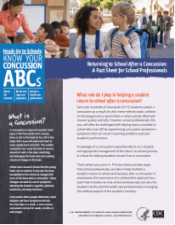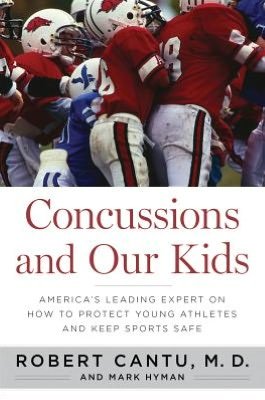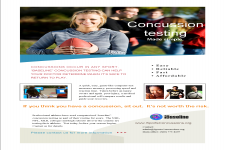What is a concussion?
- Created on Friday, 07 January 2011 07:01
- Last Updated on 21.02.2013
- Published Date
Concussion – The Basics
Introduction
Concussion is type of traumatic brain injury. While many concussions resolve quickly, in some cases the effects of concussion can last for months. Furthermore, the long-term consequences from sustaining repeated concussions can be substantial. In this overview we will define concussion and discuss how frequently it occurs. Additionally, we will explain the body mechanics that can lead to a concussion and the process by which brain cells are injured. We will walk through many of the common symptoms of concussion, as well as the appropriate management and steps needed to return to normal activities.
Definition of Concussion and How Commonly It Occurs
Simply put, a concussion is: “temporary, trauma-induced brain dysfunction.” In other words, the brain stops working properly, as a result of injury. A concussion is a complex brain injury that results from direct or indirect head trauma. While previously referred to in athletics as a “ding” or “getting your bell rung,” efforts are being made to use more appropriate terms, such as “concussion” or “traumatic brain injury” that underscore the potential seriousness of concussion. Concussion causes temporary symptoms, such as headaches, confusion, nausea, loss of consciousness, or amnesia. It is a problem of brain function, as opposed to structure – meaning concussion by itself does not cause bleeding, bruising or swelling of the brain. Therefore, a concussion cannot be seen on medical pictures of the brain such as “MRIs” or “cat scans,” also known as “CTs.”
Concussions have received a significant amount of attention in the media in the last several years, particularly those that occur in  amateur and professional sports. Recognizing the potential for serious long-term problems for athletes who sustain multiple concussions, The National Football League (NFL) and National Hockey League (NHL) have begun instituting policies designed to protect athletes from concussion and to ensure that players recover adequately following this injury. Many states now have laws in place to protect younger athletes from returning to play too soon following a concussion. It is appropriate to ask your coaches, athletic trainers, or other school officials what these policies are in your area.
amateur and professional sports. Recognizing the potential for serious long-term problems for athletes who sustain multiple concussions, The National Football League (NFL) and National Hockey League (NHL) have begun instituting policies designed to protect athletes from concussion and to ensure that players recover adequately following this injury. Many states now have laws in place to protect younger athletes from returning to play too soon following a concussion. It is appropriate to ask your coaches, athletic trainers, or other school officials what these policies are in your area.
The CDC estimates that there are as many as 3.8 million sport-related concussions in children and adults per year. Each year, 144,000 children are taken to the emergency department after sustaining a concussion. The highest rates of concussion in athletics occur in collision sports such as football, rugby, boys’/men’s ice hockey and boys’/men’s lacrosse. However, the rates in contact sports such as soccer and basketball, both male and female, are substantial.
Mechanism of Concussion and Brain Injury
A concussion may occur from a direct blow to the head and neck or a hit to the body with an indirect force that shakes the head, such as occurs in “whiplash” injuries. Concussion is caused by a rapid spinning (or rotational acceleration) of the head. This often occurs in sports when an athlete’s chin or head is struck by an opponent or a piece of athletic equipment. Similarly, if the athletes chin or head strikes the playing surface (field or ice) the head can be spun rapidly causing a concussion. When the skull and the brain within it are spun rapidly, the nerves or brain cells temporarily stop working properly. This interruption in normal brain cell activity leads to headaches, confusion, and other symptoms described below.
Symptoms
A symptom is something that an injured person feels or experiences. Some common symptoms of concussion include: headache, dizziness, balance problems, confusion, visual disturbances, sensitivity to light and noise, nausea, fatigue, excessive sleepiness or difficulty sleeping, loss of consciousness, convulsions, vomiting, disorientation, memory loss, attention problems, difficulty concentrating, and feeling in a “fog” or “dazed.” After a concussion, emotional symptoms can also appear including: irritability, sadness, anxiety, and rapid changes in emotion. These symptoms may change over time. Often, the more dramatic symptoms such as memory loss, confusion, vomiting, and loss of consciousness will immediately follow the concussion, while less obvious symptoms such as irritability or problems with attention and concentrating are revealed minutes, hours or a day or two later, when the more dramatic symptoms start to resolve. Regardless of how many symptoms one experiences or how severe the symptoms are, they are all characteristics of brain injury and should be discussed with your doctor or other medical professional.
Seeking Medical Attention
Anyone who sustains a head injury and is “knocked out,” has a convulsion, loses consciousness, is confused or disoriented, has persistent vomiting, or appears concerning in any other way should seek medical attention as soon as possible. If the athlete appears well and medical attention is not readily available, then it is reasonable to monitor the person closely at home. If the physician examining a patient with a concussion is concerned that there may be another injury, such as a skull fracture, bleeding in the brain, or swelling of the brain, he or she may consider getting an image of the head, such as a CT or MRI. The decision whether to do one of these tests is individualized and depends on the how the injury occurred and the patient’s physical examination. The decision is best left up to the physician managing the athlete.
Recovery, Treatment and Return to normal activities
Most concussions will heal on their own within a few days to a few weeks. In fact, 98% of high school athletes recover from their concussions within a month of the injury. The most important aspect of treatment and recovery is REST. There are 2 types of rest: physical and cognitive. Physical rest means avoiding vigorous exercise – avoiding activities that increase the heart rate. Cognitive rest is equally important and often overlooked. The word “cognitive” is used to describe activities that involve thinking, concentrating, remembering, or other intellectual activities. Cognitive rest means avoiding or at least minimizing cognitive activities. Common cognitive activities include schoolwork, reading, playing card or board games, playing video or computer games, and text messaging. Typically the more dedicated one is about rest and recovery; the quicker one can return to normal activities.
Returning to sports should be done in progressive stages. The following recovery plan was adapted from the most recent International Conference on Concussion in Sport. Typically, each step occurs over a 24-hour period monitored by medical personnel, such as a doctor or athletic trainer. An individual must remain symptom free in order to progress to the next stage. If symptoms return at an activity level, the athlete should return to the prior symptom-free step for at least 24 hours.
Step:
1. Complete physical rest
2. Light aerobic exercise, such as walking or easy (low effort) stationary cycling.
3. Sport-specific exercise, such as ice skating, swimming, or running.
4. Non-contact training drills and progressive resistance training
5. Medical clearance
6. Full contact practice
7. Return to play
Conclusion
A concussion is temporary, trauma-induced brain dysfunction. It is a complex form of traumatic brain injury. This injury can result in headaches and functional disturbances that lead to the symptoms discussed above. Concussion is not bleeding, bruising, or swelling of the brain. Typically, the brain is able to recover from a sport-related concussion within a few days or weeks; however, some individuals may experience symptoms for several weeks or months. Regardless, the most important aspect of recovery from concussion is physical and cognitive rest. If you think that you or someone you know has sustained a concussion, be sure to talk with a medical professional.
Further Reading and Resources
Website sponsored by the Centers for Disease Control and Prevention:
www.cdc.gov/concussion
Website shttps://d by the American Academy of Pediatrics. Search “Concussion”:
www.healthychildren.org
Website sponsored by the National Federation of State High School Association. Search “Concussion”:
www.nfhs.org
Meehan, W. P. (2011) Kids, Sports, and Concussion: A Guide for Coaches and Parents.
Satan Barbara, CA: Praeger
McCrory, P., Meeuwisse, W., Johnston, K., Dvorak, J., Aubry, M., Molloy, M., & Cantu, R. (2009). Consensus statement on concussion in sport: the 3rd International Conference on Concussion in Sport held in Zurich, November 2008 Journal of athletic training, 44(4), 434–448.
Réjean M. Guerriero, DO*† and William P. Meehan III, MD*‡§║

*Brain Injury Center, †Department of Neurology, ‡Sports Concussion Clinic, Division of Sports Medicine and §Division of Emergency Medicine, Children’s Hospital Boston, Harvard Medical School, Boston, MA; ║The Micheli Center for Injury Prevention and Health Promotion of the Young Athlete, Waltham, MA
Brain Health
It is rare for a sports-related concussions to result in a more serious injury such as a skull fracture or hematoma. Nonetheless, it pays to be aware that catastrpohic injuries do sometimes occur as ...
read more...-
CT scans may increase brain cancer risk
Children and young adults scanned multiple times by computed tomography (CT), a commonly used dia...
-
Sub-concussive impacts may affect learning
MINNEAPOLIS – A new study suggests that head impacts experienced during contact sports such as ...
-
Physical activity boosts learning
INDIANAPOLIS – School administrators looking to restructure the academic schedule should consid...




Neuroscience
Athens, Ga.- University of Georgia researchers have developed a map of the human brain that shows great promise as a new guide to the inner workings of the body's most complex and critical organ.
...
read more...-
Does CTE infect neuron to neuron?
NFL Hall of Famer "Iron Mike" Webster's life ended in 2002 when he suffered a heart attack at age...
-
Progesterone seems to protect neurons after injury
It is not yet known why girls suffer concussions at a higher rate than boys. The most prevalent...
-
Amino acids may restore concussion's chemical imbalance
Concussions are often called the "invisible" injury because they are usually not detectable by t...
Resources
- School professionals play an important role in the health of all students. Recognizing the signs and symptoms of concussion is important, as is managing their return to school ...
- https://
- CDC's Concussion Training for Clinicians
-
Concussion Education Video Programs - Free and Easy
Parents, athletes, coaches and medical professionals have access to concussion education created...
-
New concussion guidelines for team physicians
INDIANAPOLIS – Team physicians who assess and treat athletes suspected of concussion have new ...
quick links
Latest News
Concussions Occur...
...in Any Sport
REMOVE athlete from play
REFER to medical provider
REST no sports, no texting/TV
RETURN only with doctor's OK
Source: Children's Hospital Boston, Sports Concussion Clinic


































